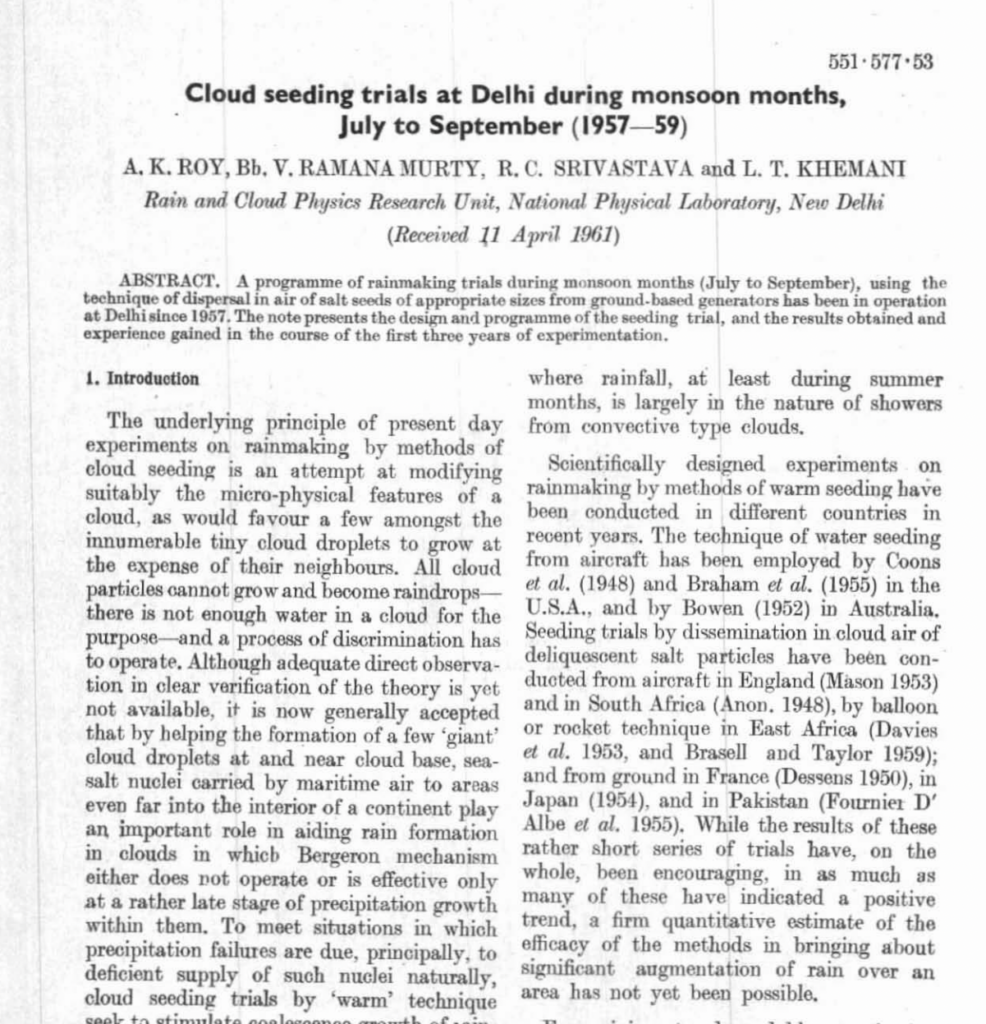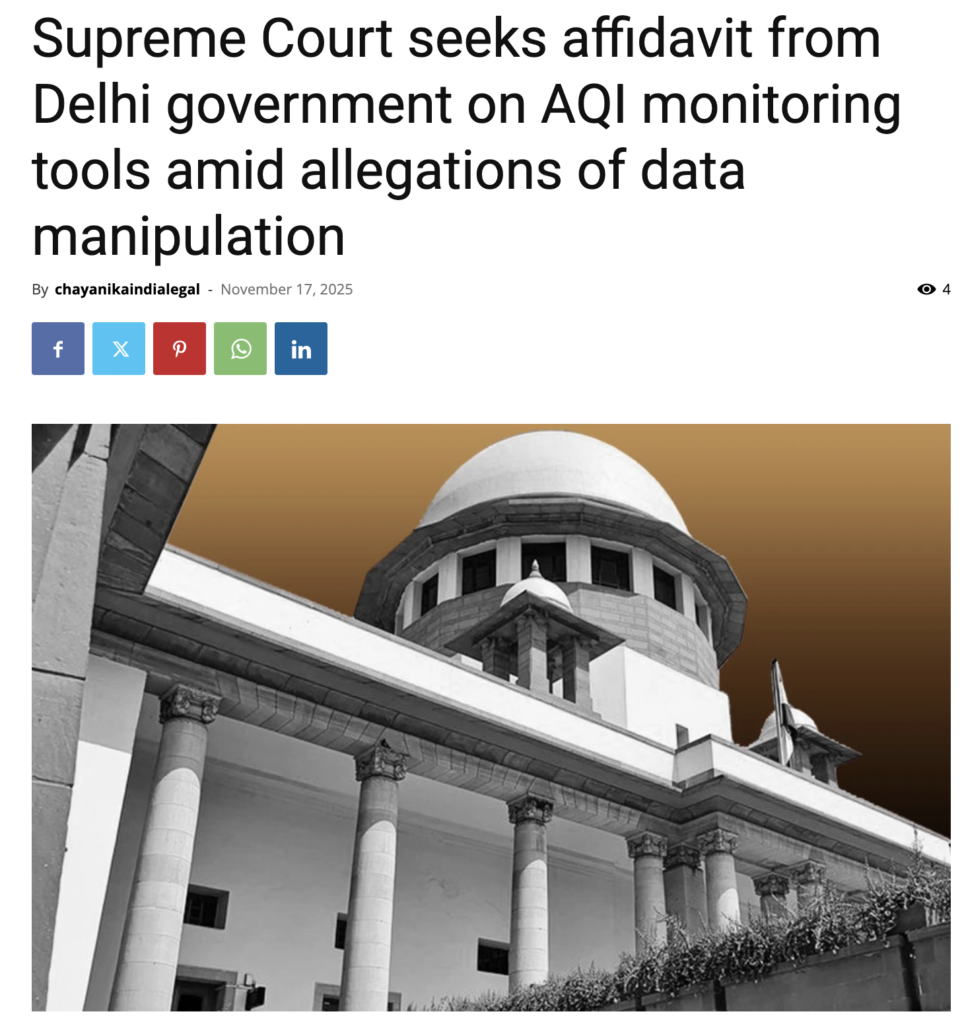Cloud Seeding in India
India has a rich history in cloud seeding research. In 1951, the Tata company conducted early rain-making experiments in the Western Ghats using silver iodide generators set up on the ground.
Dr. Banerji performed cloud seeding experiments with salt and silver iodide via hydrogen-filled balloons in 1952.
A committee by CSIR recommended establishing a Rain and Cloud Physics Research (RCPR) Unit in 1953 for cloud physics and rainmaking studies.
RCPR executed a long-term cloud seeding program in north India from 1957 to 1966.
The RCPR later became part of the Indian Institute of Tropical Meteorology (IITM).


Did you know?
The 1957 Delhi trial used ground sprayers, not aircraft, to push salt particles into clouds.
IITM conducted cloud seeding experiments in Tiruvallur (Tamil Nadu) during the 1970s, as well as over Mumbai and Rihand 4 catchment in Uttar Pradesh.
In 1975, operational cloud seeding was attempted over Linganamakki in Karnataka, but results could not be assessed due to operational nature.
IITM also carried out cloud seeding in Baramati (Maharashtra) from 1973 to 1986, achieving a 24% increase in rainfall.
A comprehensive review of Indian cloud seeding studies is provided by Kulkarni et al. (2008).
Cloud seeding experiments in Delhi some 55 years ago.
— Roxy Koll ⛈ (@RockSea) October 24, 2025
— from IITM Annual Report, 1971–72. pic.twitter.com/ejJeya7KWN
The cloud seeding scientific activity was limited from 1980-1990 due to a lack of new findings.
Significant advancements in airborne instrumentation, radars, flares, and software occurred in the 1990-2000 decade.
The South African cloud seeding experiment was conducted from 1991-1995, utilizing new technologies that resulted in a statistical increase in rainfall across all cloud types.
Notable cloud seeding programs include:
– Mexican Experiment: 1996-1998
– United Arab Emirates Experiment: 2001-2004
– Italy Experiment: 2004-2005
– Indonesian Experiment: 2005
– Wyoming Experiment: 2005-2010
– Southeast Queensland Cloud Seeding Experiment: 2008-2010
A brief history of cloud seeding in India:
| Year | Location / Program | Lead Agency / Organizer | Method | Key Details / Reported Outcome | Status |
|---|---|---|---|---|---|
| 1951 | Western Ghats (Maharashtra) | Tata Group (private) | Ground-based silver iodide (AgI) | First cloud seeding in India for hydropower | Operational (private) |
| 1952 | Western Ghats + northern India | IMD (S. K. Banerji) | Hydrogen balloons + salt/AgI | Early national experiments | Exploratory |
| 1957–1959 | Delhi (monsoon) | National Physical Laboratory (NPL) | Ground-based common salt (hygroscopic) | India’s first Delhi trial; inconclusive due to variability | Experimental |
| 1971–1972 | Delhi (winter) | IITM Pune (early stage) | Ground-based silver iodide | ~17% preliminary increase; 11 seeded vs 11 control days | Experimental |
| 1973–1974 | Bengaluru & surrounding Karnataka | Karnataka govt + IMD | Ground-based salt generators | Early state-level trial | Operational (small) |
| 2003–2004 | Karnataka (monsoon drought relief) | Karnataka State Govt | Aircraft + salt & AgI | Rainfall reported ~100 km away | Operational |
| 2009 | CAIPEEX Phase I (Pune region) | IITM / MoES | Purely observational (no seeding) | Aerosol-cloud baseline study | Research |
| 2011 | CAIPEEX Phase II | IITM / MoES | Aircraft microphysics observations | Detailed cloud physics | Research |
| 2017 | Project Varshadhari | Karnataka Govt + IISc | Aircraft (hygroscopic + AgI) | 10–20% enhancement; Gadag, Yadgir, Bengaluru fringes | Operational |
| 2017 | CAIPEEX Phase III | IITM / MoES | High-altitude aerosol & cloud studies | No seeding | Research |
| 2018–2019 | CAIPEEX Phase IV (Solapur, Maharashtra) | IITM / MoES | Randomized hygroscopic seeding (aircraft) | 18% average, up to 46% gain; first statistically robust result | Scientific success |
| 2018 onward | Maharashtra monsoon operations | Maharashtra Govt | Aircraft-based seeding | Annual drought relief | Operational |
| 2022–2025 | Maharashtra + Karnataka renewals | State governments | Aircraft (hygroscopic + AgI) | Continued annual operations | Operational |
| 2023 | CAIPEEX Phase IV final report published | IITM | — | 867 million litres extra water in Solapur | Published |
| 2024 (Nov) | Delhi (post-Diwali pollution + rain) | Delhi Govt + IITM/IIT-Kanpur | Aircraft silver iodide + salts | Third historical Delhi trial; mixed pollution/rain goal | Operational (one-off) |
| 2024–2025 | Rajasthan drone pilot | Rajasthan Govt + private firms | Drone-based AgI | New technology testing | Pilot |
| 2025 | Delhi repeat (planned) | Delhi Govt | Aircraft seeding | Pollution + winter rain enhancement | Proposed |
| 2025–2026 | Himalayas (Uttarakhand, Himachal, Ladakh) | MoES / IITM + state govts | Aircraft + drone (AgI + hygroscopic salts) | Pilots actively planned — still awaiting final approval | Planned (no operations yet) |
The National Air Quality Index (AQI) in India was launched on September 17, 2014, in New Delhi, as part of the Swachh Bharat Abhiyan (Clean India Mission).
The AQI was developed by the Central Pollution Control Board (CPCB) in collaboration with experts from the Indian Institute of Technology, Kanpur (IIT-Kanpur), as well as medical professionals, academia, and various air quality advocacy groups.
The Central Pollution Control Board (CPCB) releases the Air Quality Index (AQI) in India, in coordination with the Ministry of Environment, Forest and Climate Change (MoEF&CC). Other organizations like State Pollution Control Boards (SPCBs) and the System of Air Quality Forecasting And Research (SAFAR) also contribute to monitoring and reporting air quality.
The National Air Quality Index (AQI) is a system launched by the Indian government to provide a single, easy-to-understand description of air quality based on “One Number – One Colour – One Description“
Are Governments Really Playing with Public Health?

The Controversy Surrounding Air Quality Index Manipulation
The issue of air pollution is a significant concern for many people around the world. However, some people believe that the government is manipulating AQI data to serve their own interests.
There is a belief that AQI data might be being manipulated to increase purifier sales, mask sales, as well as to shut down schools and public places. Promoting fear by declaring the necessity of coordination with hospitals and emergency services to prepare for an increase in respiratory complaints and other health problems.
#WATCH | Delhi: On Delhi's air pollution, Dr Anant Mohan, HOD of pulmonary medicine and sleep disorders, AIIMS, says, "The pollution here is absolutely severe and life-threatening. This situation has been going on for the last ten years. We try to do something every time, but in… pic.twitter.com/jgE9lqeVRS
— ANI (@ANI) November 18, 2025

On a day when the AQI is predicted to be elevated due to fine particle pollution, an agency or public health organisation might:
- Advise sensitive groups, such as the elderly, children and those with respiratory or cardiovascular problems or suffering from diseases, to avoid outdoor exertion.
- Declare an “action day” to encourage voluntary measures to curtail air emissions, such as using public transportation.
- Recommend the use of masks outdoors and air purifiers indoors to prevent fine particles from entering the lungs.

What the Allegations / Concerns Are
- Water Sprinklers Near Monitors
- Investigations (e.g., by Newslaundry) found truck-mounted water sprinklers being used near some air quality monitoring stations in Delhi.
- The concern: watering around the sensor suppresses dust/particulates, which could artificially lower the recorded PM 2.5 / AQI readings.
- At Anand Vihar, a reality check by journalists found that while a display board showed a relatively low PM2.5 (~73 μg/m³), the data on the Delhi Pollution Control Committee (DPCC) website for the same station/time was much higher (~248 μg/m³) — suggesting a discrepancy.
- Monitor Placement & Protocol Violations
- According to a Newslaundry investigation, many government / public continuous ambient air quality monitoring stations are violating placement norms (e.g., being blocked by trees or being too close to buildings), which can bias readings.
- These placement issues affect representativeness of the data: if sensors are surrounded by obstructions, airflow is not uniform, and readings may not reflect “true ambient” air.
- Data Gaps / Missing Data
- There are reports of missing or incomplete data in some official apps/stations.
- Also, Newslaundry pointed out that in places like Connaught Place (Delhi), AQI displays and data were unavailable or faulty.
- Public Perception & Trust Issues
- These controversies have raised questions about the credibility of AQI data, especially during pollution spikes (e.g., around Diwali).
- Some environmentalists have called these “scientific fraud” if data is being manipulated to show lower pollution.

Ref:
- https://www.newslaundry.com/2025/10/30/delhi-aqi-fraud-water-sprinklers-cleaning-the-data-not-the-air?utm_source=chatgpt.com
- https://www.indiatoday.in/india/video/delhi-gasps-citizens-protest-toxic-air-allege-aqi-data-fraud-ytvd-2816261-2025-11-09
- https://english.mathrubhumi.com/news/india/delhi-aqi-fraud-water-sprinklers-manipulate-pollution-data-mfufc5cd
- https://www.tropmet.res.in/~lip/Publication/Technical-Reports/CAIPEEX-Report-July2023.pdf
- https://www.drishtiias.com/pdf/1663232215.pdf
- https://www.thehansindia.com/posts/index/Technology/2018-08-28/Purelogic-Labs-Introduces-Indias-First-Motorized-Prana-Air-Motion-Mask/408219?
- https://www.pranaair.com/in/fresh-air-machine/
- https://www.franchiseindia.com/insights/en/article/purelogic-labs-india-brings-out-motorized-prana-air-motion-mask.51420?
- https://en.wikipedia.org/wiki/Air_quality_index#cite_note-3
Also Read:
